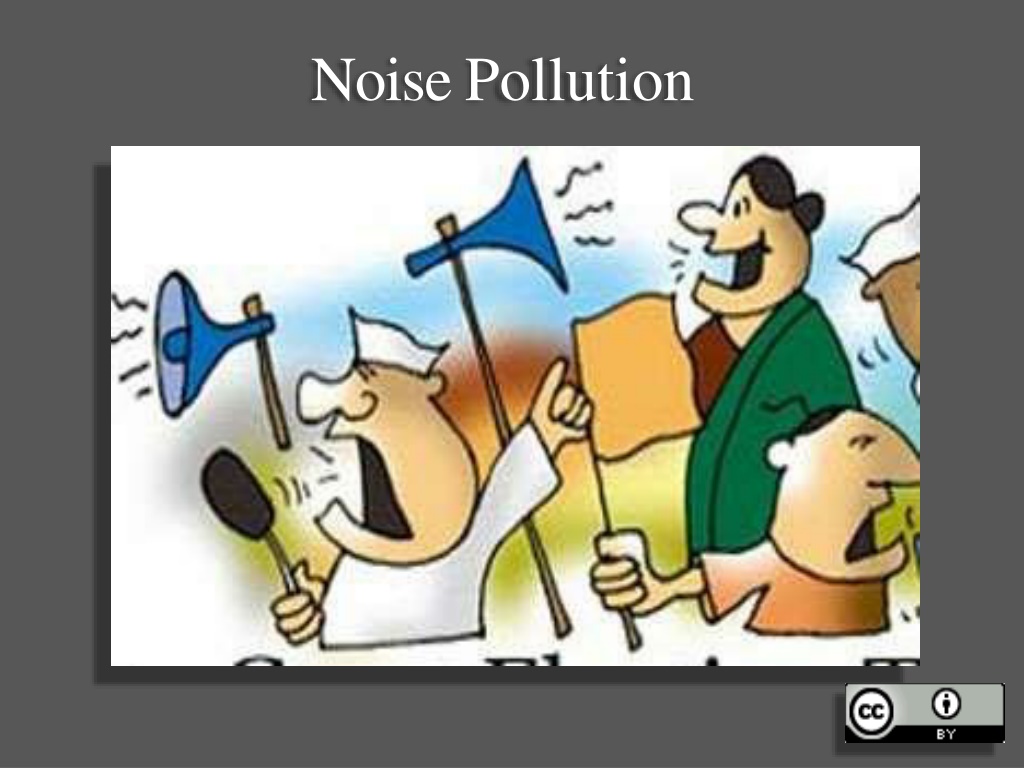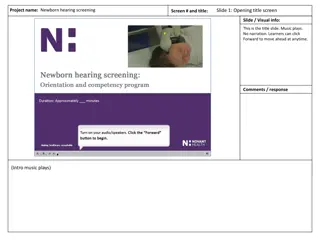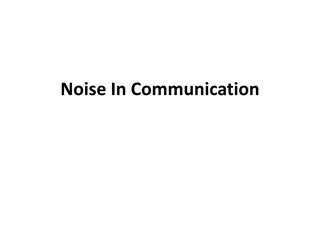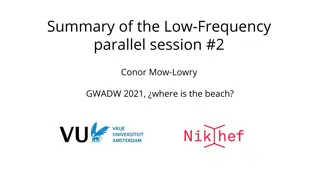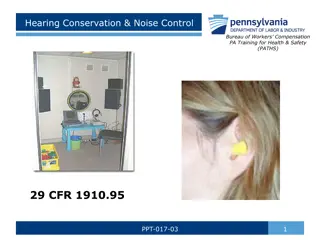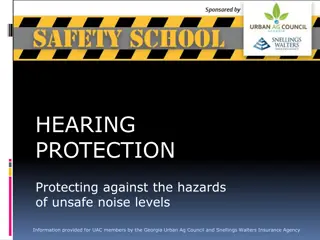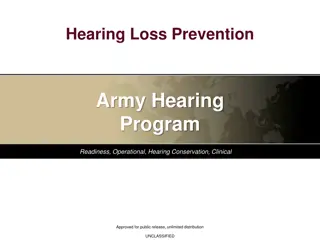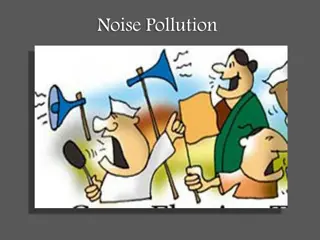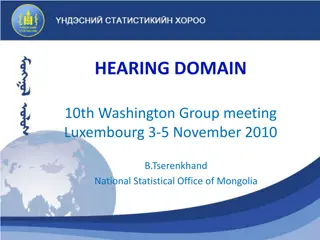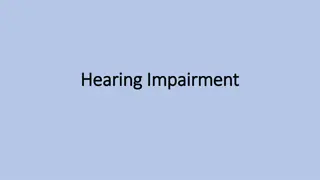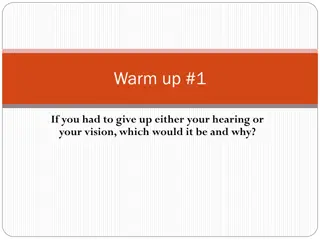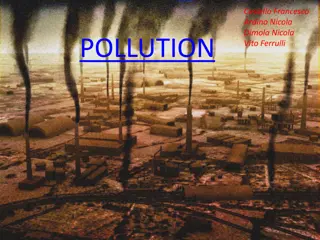Understanding Noise Pollution and Mechanism of Hearing
Noise pollution is defined as unwanted human or machine-created noise that disrupts daily life. This term is explained along with terminology related to frequency and intensity of sound in this informative content. Additionally, the mechanism of hearing is detailed, describing how sound waves are processed through the ear to be interpreted by the brain.
Download Presentation

Please find below an Image/Link to download the presentation.
The content on the website is provided AS IS for your information and personal use only. It may not be sold, licensed, or shared on other websites without obtaining consent from the author. Download presentation by click this link. If you encounter any issues during the download, it is possible that the publisher has removed the file from their server.
E N D
Presentation Transcript
Noise Pollution Definition Noise is define as any undesirable human or machine created noise which disturbs the activity or balance of human or animal life .
Terminology used in noisepollution Frequency: Frequency is the no of cycles repeated in unit time duration. Its unit is cycle/sec or Hz ( 1 Hz=1 Cycle/sec) Intensity: Amount of sound energy received / sec is known as intensity of sound. Its Unit is decibel ( dB).
Decibel: Decibel is define as the logarithm to the base 10 to ratio of twointensities Lt=10 log 10 (I/I0) dB Where, I= MeasuredIntensity I0= Reference Intensity Lt= Level of noise indB
What isNoise? In simple terms, noise is unwanted sound. Sound is a form of energy which is emitted by a vibrating body and on reaching the ear causes the sensation of hearing through nerves. Sounds produced by all vibrating bodies are not audible. The frequency limits of audibility are from 20 HZ to 20,000 HZ. A noise problem generally consists of three inter-related elements- the source, the receiver and the transmission path. This transmission path is usually the atmosphere through which the sound is propagated, but can include the structural materials of any building containing the receiver
The Sound of Human Speech is mainly in the range of 300 to 3000 Hz
Mechanism ofHearing The Science of Human hearing and sound is called human acoustics. Sound waves set vibration in the ear drum which is made up of membrane In the upper ear. The vibration in the Ear drum induces movement of three small soft bones in the middleear behind the ear drum. The movement of the soft bones pass through viscous fluid in the inner ear creating oscillation of Fluid. These oscillation then reaches the auditory nerves and finally transmitted to thebrain. The oscillation or sound are identified and interpreted in the brain, which has capacity to analyze sound into different frequency. Human detectable frequency range is 20 to 20000Hz. Sensitivity of the Ear varies from person to person, with aging hearing power decreases. The ear is susceptible to damage if it receives high intensity noise.
Measurement of Noise ( Sound) The Intensity of Sound is measured in terms of Sound pressure Level and common unit isdecibel Decibel (dB) = 10 log 10(I/I0) Thus dB measures how much intense is the sound as compared to reference intensity The Sound pressure level ( SPL) in dB is Def nas SPL= 20 log 10(P/P0) Where, P= Measured pressure Po= reference pressure ( 2 x 10 -5N/m2)
Noise Level in Decibel is measured with an instrument called sound level meter. It consists of 3 internationally accepted weighing network The weighing networks are electronic filter circuits build into the meter to weaken certain frequency. They permit the sound level meter to respond more to some frequency than to others with prejudice something like human ears There are 3 weighingscales A weighing scale- Severely filters thefrequency B weighing scale- Moderately frequency C weighing Scale- Hardly filtersfrequency filters the
A weighing Scale (dBA) The sensitivity of human ears depends on the frequency or pitch of the sound. We hear some frequency better than others. e.g. If a person hears two sounds of same sound pressure but different intensity one sound may appear louder than the other. This happens when we hear high frequency much better than lower frequency noise. An A-weighing filter, adjusts the measured sound level to correspond to this peculiarity of human hearing. It filter out low frequency or pitches.
Sources OfNoise Major Sources of Noise: Traffic Noise: Automobile revolution in urban areas are proved to be a big source of Increase in traffic has given rise to traffic jams, where the repeated hooting of horns by drivers create noise pollution. Air crafts creates serious problems in big cities like Mumbai &Delhi Heavy truck, motorcycles, jeeps, other vehicles are responsible for traffic noise. noise pollution. buses, trains,
Industrial Machinery Noise:- Factory equipments, generators, drills, road rollers, and similar machinery also make lot of noise. Public address system contribute in its own ways towards noise pollution by using loud speakers for religious functions, birth, marriage, election advertising Household:- The household activities will contribute pollution domestic pressure cookers, cleaners, mixers, washing machines are major source of noise at house hold level. Entertainment equipments like radio, music system, T.V. Will contribute toward noise pollution And Construction System:- Public for commercial for indoor gadgets A.C, noise like Vacuum
Defense Exercises:- Tanks, launching of rockets, explosion, military exercises, shooting ranges are adding toward noise pollution. aero planes,
Effects of Noisepollution Noise can do Physiological and or / Psychological damage if the volume is high or if exposure isprolonged. Common effects of Noise pollution are: Hearing Loss: Loud noise damages fine hair cell in vibration of these responsible for hearing of Sound by us, Since our body cannot replace damaged hair Hearing loss is caused by long term exposure to loud noise. the hair ear. cells is The cells. Permanent
Annoyance: annoyance receptor due to level fluctuations Physiological effects: The Physiological effects like breathing difficulty, rise in blood pressure, migraine, constriction vessels and even heart attacks. . It creates to the sound headaches, of blood
Effects of Noisepollution Human performance: The working of humans will be affected as they will lose their concentration Nervous System: It causes pain ringing in ears, feeling of tiredness, functioning of human system thereby effecting
Sleeplessness: It affects the sleeping thereby inducing the people to become restless and loose concentration and presence of mind during their activities.
Effects on animals Noise can cause serious damage to wild life. Ways in which animals are adversely affected by noise pollution includes. Hearingloss Masking: Masking is the inability tohear important environmental animal signals Physiological effects: such as increase in heart rate, respiratory difficulties and stress. Behavioral effects:-Which could result in abandonment of territory and loss of ability to reproduce. Ecological effects: It leads to migration of birds which disturbs the ecosystem clues and
Effects on plants The production capacity or growth of plant is affected due to high levelnoise. Damage tomaterial: The building and material may get damage by exposure to infrasonic/ ultrasonic waves and even get collapsed.
Control of NoisePollution Noise is not only a nuisance but a serious environmental problem and a health hazard. Like all other pollution, noise pollution is needed to be controlled. Noise pollution can be effectively controlled by measures. taking following
Control of NoisePollution Control at receivers end For people working in noisy areas ear protection aids like ear plugs, muffs, noise helmets, head phones etc should be provided it reduces occupational exposure. Controlling atsource This is only possible if working method is improved. machines lubrication and better, maintenance of machines. Installing noisy machines with sound absorbing materials. Using Silencer to control noise from automobilesetc. Design new to replace noisy ones. Proper
Zoning Increased distance between source and receiver by zoning of noisy industrial areas like bus stand and railway stations away from silence zones near residential areas, educational institutions and hospitals. SoundInsulation A) Sound insulations can be done by constructing windows with more than one panes of glass and filling the gap with sound absorbing material. B) Acoustical tiles, perforated plywood can be fixed on wall, ceilings, floors to reduce noise.
Control of NoisePollution Planting of Trees Planting of trees and shrubs along roads, hospitals, educational institutions help considerable extent. Legislativemeasures Strict legislative measures need to be enforced to control the nuisance of noise pollution some of the measures are in noise reduction to a A)Minimum use of loud speakers, near silencezones. B)Banning Pressure horns in automobiles C)Framing a separate noise pollutionact.
Damage risk criteria for hearing loss (OSHAregulations) OSHA- Occupational Safety and HealthAdministration
